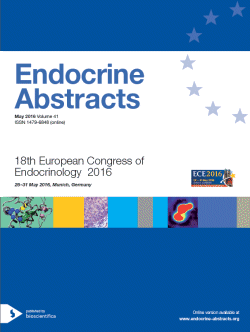Searchable abstracts of presentations at key conferences in endocrinology
Symposia
In the rhythm of EYES: Let's dance!
ea0041s15.1 | In the rhythm of EYES: Let's dance! | ECE2016
The Microbiome Waltz – cross-regulation of rhythmic oscillations at the host-microbiota interface
All domains of life feature diverse molecular clock machineries that synchronize physiological processes to diurnal environmental fluctuations. However, no mechanisms are known to cross-regulate prokaryotic and eukaryotic circadian rhythms in multi-kingdom ecosystems. We discovered that the intestinal microbiota, in both mice and humans, exhibits diurnal oscillations, leading to time-specific compositional and functional profiles over the course of a day. The active phase of t...
ea0041s15.2 | In the rhythm of EYES: Let's dance! | ECE2016
Jive up your judgement! Density is not the destiny – the lessons from vertebral morphometry and bone turnover in acromegaly
Skeleton is an emerging target for systemic complications in acromegaly. The GH/IGF-1 excess is believed to cause an increased bone turnover and negative calcium balance. Observations on bone mineral density (BMD) in acromegalic patients are inconsistent, possibly in relation to skeletal site and method of BMD measurement or gonadal status. Reports on skeletal fragility are also conflicting but it is predominantly believed that an increase of vertebral fractures (VFs) risk is ...
ea0041s15.3 | In the rhythm of EYES: Let's dance! | ECE2016
Chemokine receptor CXCR4 – important role in human adrenal physiology and tumour disease?
Introduction: Chemokines are small secreted molecules that promote cell survival, proliferation and directional guidance of migrating cells in normal physiology and tumour pathophysiology. We have recently observed high CXCR4 mRNA expression both in normal human adrenals and in adrenocortical carcinomas. Furthermore, a PET tracer for selective molecular imaging of CXCR4-expression has recently been established.Objective: To further investigate CXCR4 prot...




